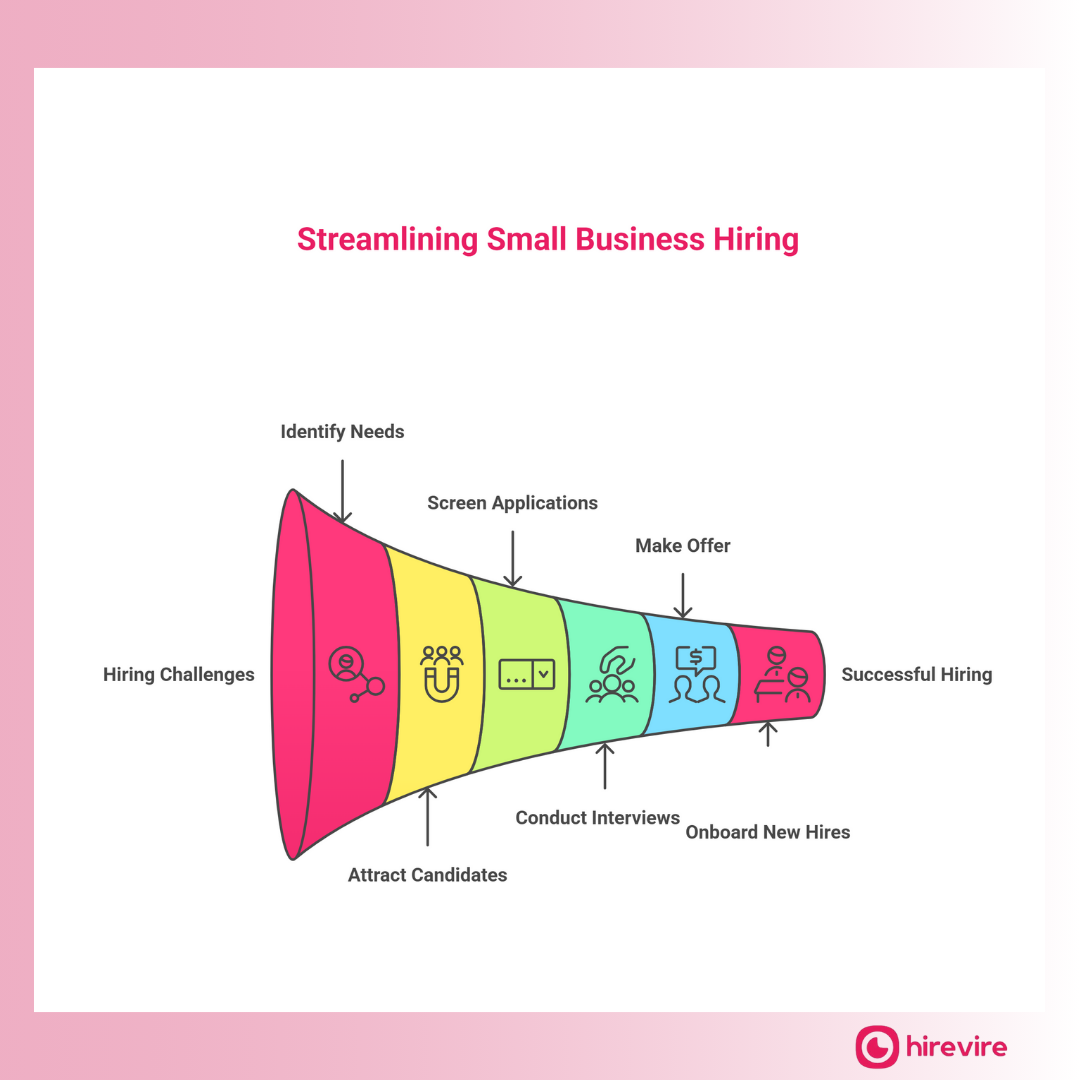Summary:
Small businesses face significant challenges in hiring, with 63% struggling to find qualified candidates, often resulting in high costs and lengthy processes. Many are turning to international talent pools due to a shortage of U.S. candidates. However, small businesses have advantages like faster decision-making, personal candidate experiences, and unique company cultures. By leveraging technology and strategic recruitment practices, small businesses can streamline their hiring processes, compete effectively with larger companies, and capitalize on their inherent strengths to attract top talent.
Table of Contents
The Small Business Hiring Reality
Your Competitive Advantage is Closer Than You Think
What You'll Learn in This Complete Guide
Small Business vs Enterprise Hiring: Understanding Your Unique Position
Small Business Hiring Challenges
Small Business Hiring Advantages
The Numbers Work in Your Favor
Complete Step-by-Step Small Business Hiring Guide
Step 1: Identify Your Hiring Needs
Step 2: Create Compelling Job Descriptions
Step 3: Choose the Right Recruitment Channels
Step 4: Streamline Application Collection
Step 5: Efficient Candidate Screening
Step 6: Structured Interview Process
Step 7: Decision Making & Onboarding
Small Business Hiring Checklist: Your Complete Action Plan
Post-Hiring : New Employee Onboarding
Small Business Interviewing Tips & Best Practices
Video Interview Best Practices
Hiring Your First Employee: A Founder's Guide
Legal and Administrative Setup
Why Hirevire is Perfect for First-Time Hiring Managers
How to Streamline Recruitment and Selection
Hirevire's Role in Streamlining
Small Business Hiring Dos and Don'ts
Recruitment Plans for Small Businesses
Technology Solutions That Level the Playing Field
Emphasize Competitive Advantages
Transform Your Hiring Process Today
1. How much should small businesses budget for hiring?
2. How much time does proper hiring actually take?
3. What legal requirements must small businesses follow when hiring?
4. Is hiring technology too complex for small businesses?
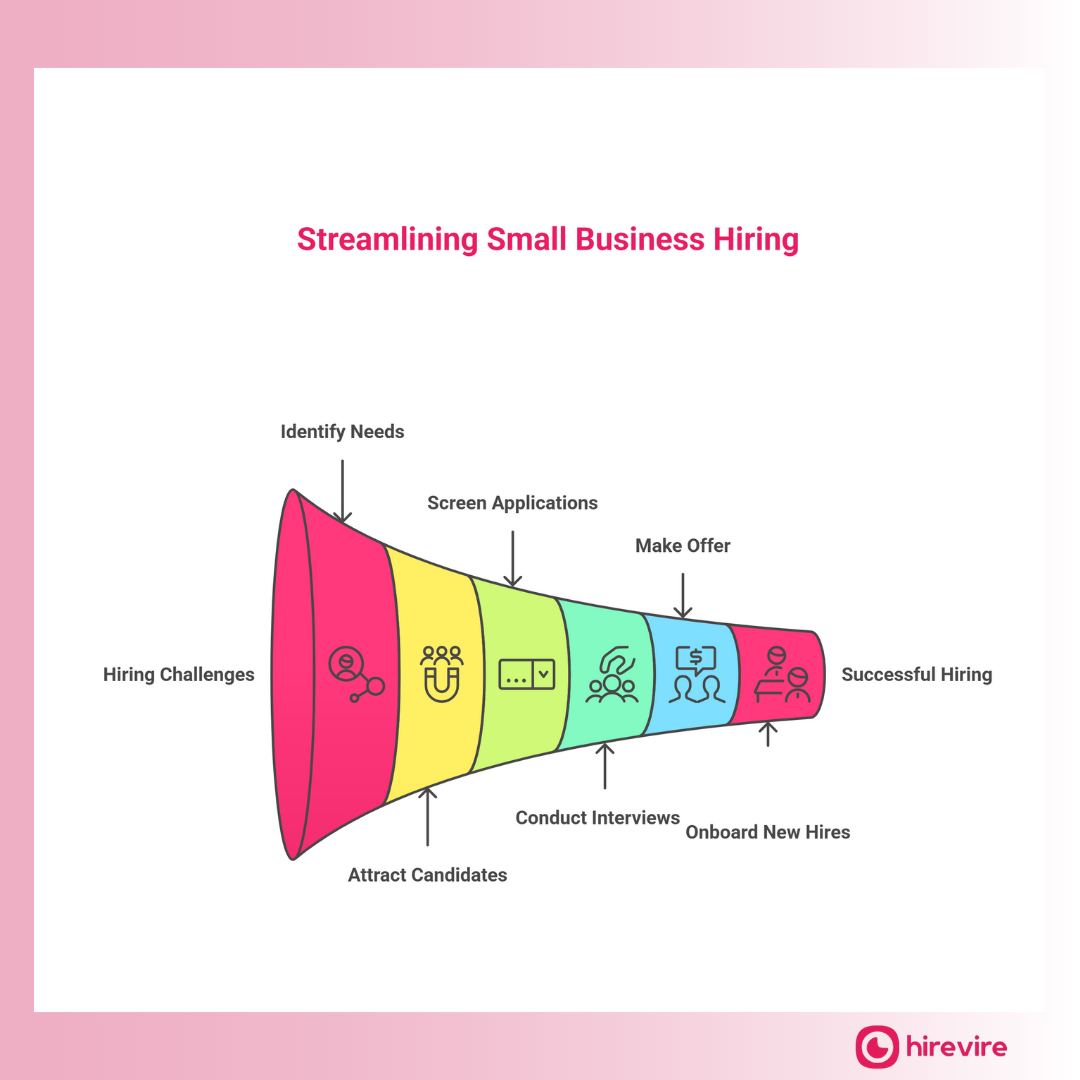
Finding the right employees for your small business shouldn't feel like searching for a needle in a haystack. Yet for countless small business owners, hiring has become one of their biggest operational headaches.
The Small Business Hiring Reality
Here's a sobering truth: 63% of small businesses struggle to find qualified candidates. This shows that the hiring process for small business is not easy. With the average cost-per-hire hovering around $4,700 and time-to-hire stretching to 23.8 days, small businesses are spending precious resources on a process that often feels broken.
But here's what makes it even more challenging – 58% of small business owners are now turning to international talent pools because they simply can't find enough qualified U.S. employees. Meanwhile, recruiters are drowning in administrative tasks, spending 78% of their hiring time on paperwork instead of actually evaluating candidates.
Your Competitive Advantage is Closer Than You Think
The good news? Small businesses actually have several hidden advantages over their enterprise competitors when it comes to hiring:
- You can make decisions 34% faster than large corporations
- Candidates often prefer the personal touch and growth opportunities small businesses offer
- You have the flexibility to create truly unique employee experiences
- Your company culture can be a powerful differentiator in attracting top talent
What You'll Learn in This Complete Guide
This comprehensive guide will transform how you approach small business recruitment by showing you:
✅ The 7-step hiring process specifically designed for small business needs
✅ Proven strategies to compete with larger companies for top talent
✅ Technology solutions that level the playing field without breaking your budget
✅ Real-world checklists and templates you can implement immediately
✅ Cost-effective screening methods that save time while improving hire quality
Throughout this small business hiring guide, we'll explore how modern tools like Hirevire are helping small businesses automate their screening processes, collect video and audio responses from candidates, and how to hire employees small business – all while maintaining the personal touch that makes small businesses special.
Whether it is your company’s first employee hiring process or you’re looking to scale your team efficiently, this guide provides the roadmap to build a hiring process that actually works for your business.
Small Business vs Enterprise Hiring: Understanding Your Unique Position
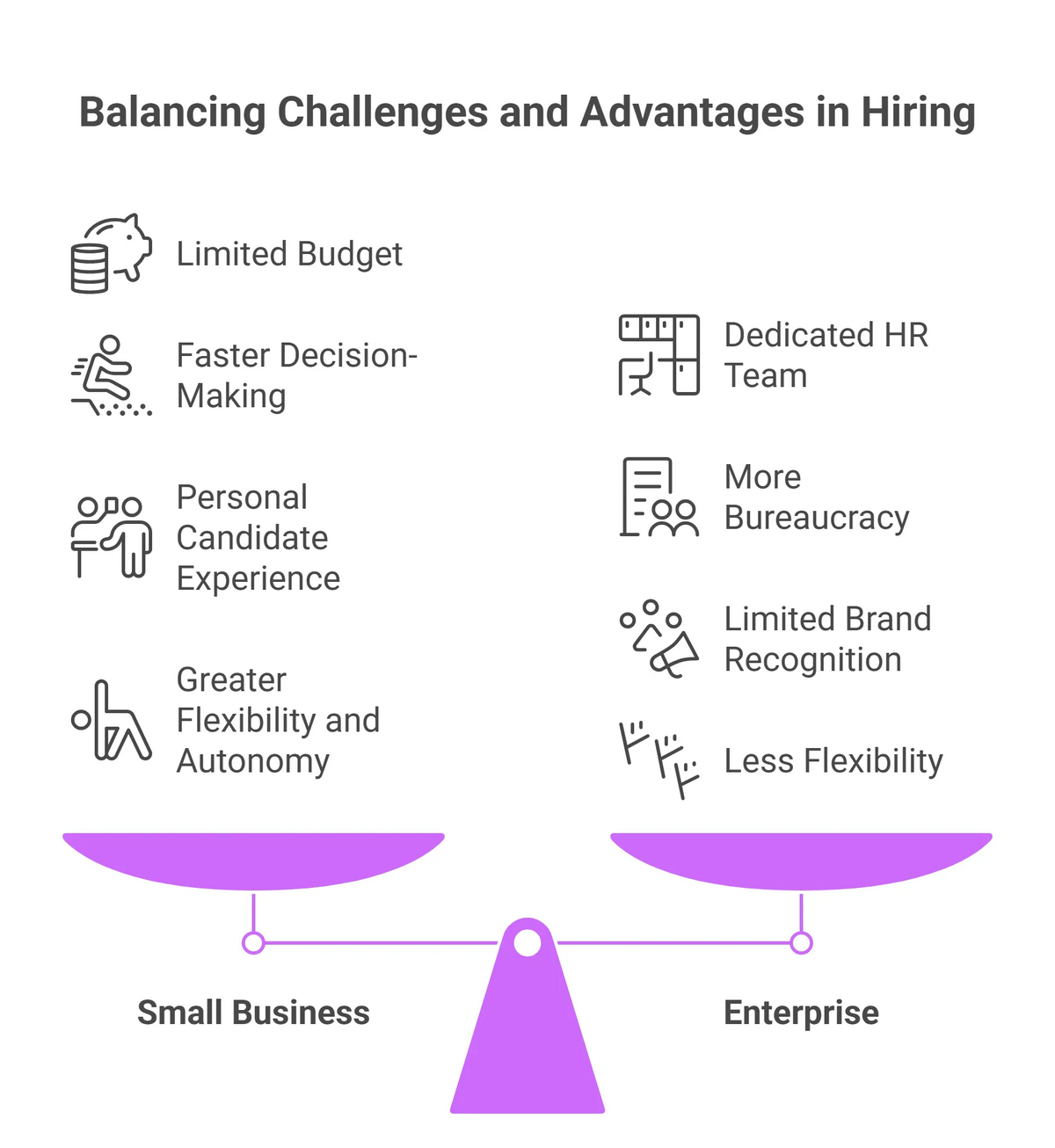
Small business hiring isn't just enterprise hiring on a smaller scale – it's a completely different game with its own rules, challenges, and opportunities.
Small Business Hiring Challenges
Limited Budget
Most small businesses work with an average recruitment budget of $1,600 per year, while enterprise companies can spend tens of thousands per position. Every hiring dollar needs to deliver maximum impact.
No Dedicated HR Team
56% of small businesses struggle with time management during hiring because there's no dedicated HR department. You're likely juggling recruitment alongside running operations, managing finances, and handling customer service.
Competing with Larger Companies for Talent
When candidates are choosing between your growing business and a Fortune 500 company with signing bonuses and comprehensive benefits, the competition feels overwhelming.
Higher Stakes Per Hire
In a 10-person team, one bad hire affects 10% of your workforce. Every hiring decision carries more weight when you have fewer positions and smaller margins for error.
Limited Brand Recognition
Unlike household-name corporations, you're starting every candidate conversation by explaining who you are before you can even discuss the opportunity.
Small Business Hiring Advantages
Faster Decision-Making
While enterprises navigate committees and approval chains, you can make hiring decisions in days. Smart candidates recognize this speed as a sign of less bureaucracy overall.
More Personal Candidate Experience
Your candidates meet actual decision-makers, not the 15th HR representative. They see where they'll work, meet future teammates, and understand exactly how their role impacts the business.
Greater Flexibility and Autonomy
Need someone to start in two weeks? Want to create a hybrid role? Small businesses can customize opportunities and working arrangements that rigid corporate structures cannot match.
Stronger Company Culture Connection
Your culture isn't a corporate initiative – it's the authentic result of working closely with a small team. Candidates can actually experience this during the interview process.
Less Bureaucracy
Ambitious professionals increasingly value the ability to make real decisions and see direct results. Small businesses offer something enterprises struggle with: the chance to actually move the needle.
The Numbers Work in Your Favor
The hiring landscape reveals opportunities for nimble small businesses. The average time-to-hire in the United States is 23.8 days, with an average cost-per-hire of approximately $4,000. However, small businesses that streamline their processes often move faster and more cost-effectively than these averages.
Most telling: 58% of small business owners are turning to international talent because they're facing a shortage of available U.S. employees. This trend opens access to a global talent pool that often values small business opportunities over corporate limitations.
Your size isn't your limitation – it's your competitive advantage.
Complete Step-by-Step Small Business Hiring Guide
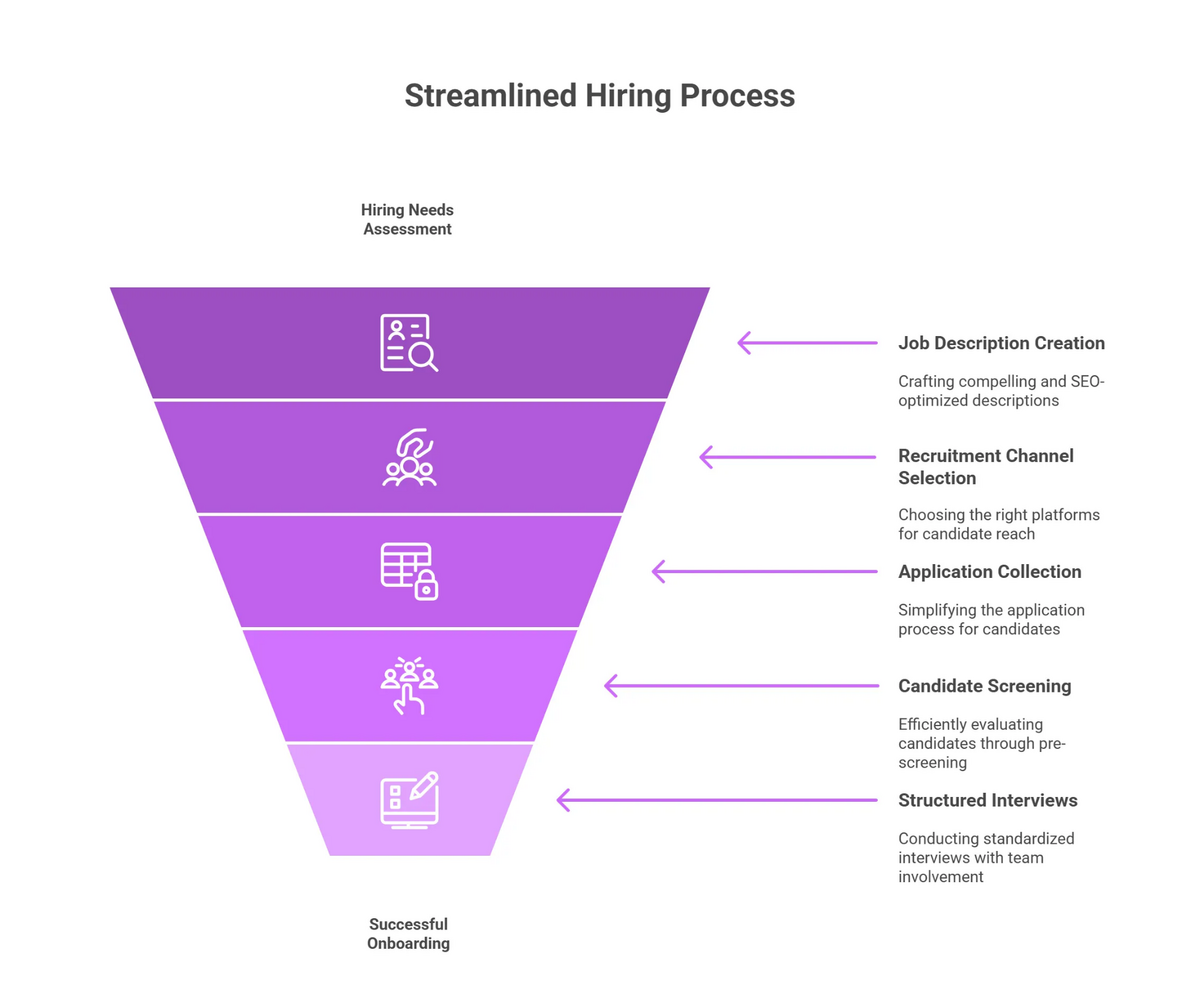
Building an effective hiring process doesn't require an enterprise budget or dedicated HR team. Follow these seven proven steps to create a streamlined system that attracts top talent while saving time and money.
Step 1: Identify Your Hiring Needs
Assess Current Team Capabilities
Start by mapping your existing team's skills and responsibilities. Identify gaps that are slowing growth or creating bottlenecks. Ask yourself: What tasks are consuming too much leadership time? Where are we turning down opportunities due to capacity constraints?
Define Role Requirements vs. Nice-to-Haves
Create two lists: must-have skills and preferred qualifications. Small businesses often make the mistake of creating wish-list job descriptions that eliminate 90% of qualified candidates. Focus on the 3-4 essential skills that truly matter for success in the role.
Budget Planning and ROI Considerations
Calculate the true cost of the hire beyond salary – benefits, equipment, training, and productivity ramp-up time. Consider the revenue impact of filling this position versus the cost of leaving it empty. Most small businesses see positive ROI within 6-12 months for well-planned hires.
Hirevire Integration: Automated screening saves significant time during needs assessment by quickly filtering candidates based on key requirements, allowing you to focus evaluation time on truly qualified prospects.*
Step 2: Create Compelling Job Descriptions
Small Business Advantage Messaging
Highlight what large companies can't offer: direct access to leadership, significant impact on company direction, rapid skill development, and the opportunity to wear multiple hats. Position these as growth accelerators, not additional burdens.
Highlight Growth Opportunities
Be specific about advancement potential. Instead of vague "growth opportunities," explain how someone could develop from this role into leadership positions as the company scales. Share examples of current employees who've grown with the business.
Include Company Culture Elements
Describe your actual work environment, team dynamics, and company values in action. Use specific examples rather than corporate buzzwords. If you have flexible hours, remote options, or unique team traditions, mention them prominently.
SEO Optimization for Job Boards
Include relevant keywords that candidates search for, but write for humans first. Use standard job titles alongside your creative internal names. Include location-specific terms and industry-relevant skills to improve visibility in search results.
Step 3: Choose the Right Recruitment Channels
Job Boards vs. Networking
Job boards cast a wide net but require filtering many unqualified applicants. Networking yields higher-quality candidates but takes more time upfront. Use job boards for volume roles and networking for specialized positions or senior hires.
Social Media Recruitment
LinkedIn remains the gold standard for professional recruiting, but don't overlook industry-specific platforms. Facebook and Instagram work well for customer-facing roles, while GitHub attracts developers. Match your platform to your target candidate's online behavior.
Employee Referral Programs
Implement a simple referral system with meaningful incentives. Referred candidates are hired 55% faster and stay 70% longer than other hires. Even a modest $500-1000 referral bonus often pays for itself through reduced hiring costs and improved retention.
Hirevire Advantage: Multi-channel integration capabilities allow you to collect applications from various sources into one organized system, eliminating the need to manage spreadsheets and multiple platforms.*
Step 4: Streamline Application Collection
Simplify Application Process
Remove unnecessary steps that create candidate drop-off. Limit initial applications to essential information: contact details, resume, and 2-3 key questions. Save detailed questionnaires for later in the process when candidates are more invested.
Mobile-Friendly Considerations
Over 70% of job seekers use mobile devices during their search. Ensure your application process works seamlessly on smartphones. Test it yourself – if it takes more than 5 minutes on mobile, it's too long.
Document Collection Strategies
Organize required documents by interview stage. Initial applications need only resumes. Second-round candidates can provide portfolios or work samples. Final candidates submit references and certifications. This staged approach respects candidate time while gathering necessary information.
Hirevire Solution: All-in-one application system with video, audio, and file collection streamlines the entire process. Candidates can submit multiple response formats through a single link, eliminating back-and-forth communication and document management headaches.*
Step 5: Efficient Candidate Screening
According to Glassdoor, the average time-to-hire in the United States is around 23.8 days, but much of this time is wasted on unqualified candidates who looked good on paper.
Pre-screening Techniques
Use phone or video screening to quickly assess communication skills, basic qualifications, and culture fit before investing time in full interviews. A 15-minute screening call can eliminate candidates who would waste an hour in a formal interview.
Structured Evaluation Criteria
Create a simple scoring system for key requirements. Rate candidates 1-5 on essential skills, experience level, and culture fit. This standardization makes it easier to compare candidates objectively and explain decisions to your team.
Hirevire Focus: Automated video screening eliminates scheduling conflicts by allowing candidates to record responses at their convenience. Review submissions on your schedule while getting better insight into communication skills and personality than traditional phone screens provide.*
Step 6: Structured Interview Process
Standardized Questions
Develop a core set of questions for each role that every candidate answers. This ensures fair comparison and helps you evaluate specific competencies consistently. Include behavioral questions that reveal how candidates handle real work situations.
Team Involvement Strategies
Include key team members in the interview process, but assign specific areas for each person to evaluate. Have the direct manager assess technical skills while a peer evaluates collaboration potential. This distributes the evaluation workload while providing multiple perspectives.
Hirevire Benefit: Shareable application links for team collaboration allow multiple stakeholders to review candidate responses independently, then discuss insights together. This eliminates scheduling conflicts while ensuring everyone's input is captured.*
Step 7: Decision Making & Onboarding
Reference Checks
Always check references for final candidates, focusing on specific examples of performance and work style. Ask previous employers about strengths, areas for improvement, and whether they'd rehire the candidate. These conversations often reveal crucial insights not captured in interviews.
Offer Negotiations
Be prepared to negotiate on more than salary. Small businesses can often offer flexibility in start dates, work arrangements, professional development budgets, or equity participation. Know your boundaries before entering negotiations.
Smooth Onboarding Process
Create a structured first-week experience that includes meeting key team members, understanding company processes, and completing initial training. Strong onboarding increases retention rates by 82% and improves productivity by 70%.
Small Business Hiring Checklist: Your Complete Action Plan
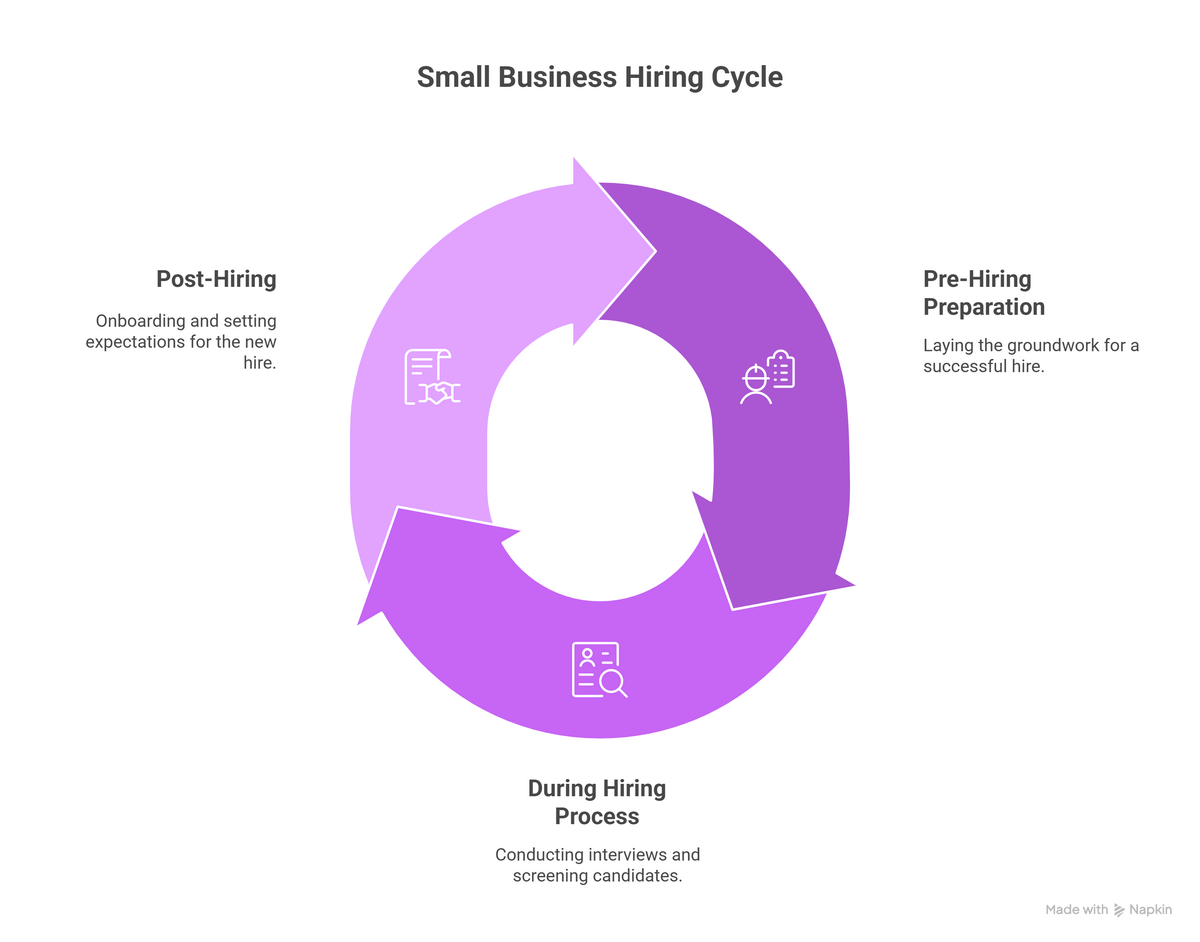
Use this comprehensive checklist to ensure nothing falls through the cracks during your hiring process. Each item is designed specifically for small business needs and constraints.
Pre-Hiring Preparation
Getting the foundation right prevents costly mistakes and legal issues down the road.
☐ Legal Compliance Check (EEO, ADA, etc.)
Verify your job descriptions use inclusive language and comply with Equal Employment Opportunity regulations. Ensure your interview questions don't touch on protected characteristics like age, religion, or family status. Review ADA requirements for workplace accommodations.
☐ Budget Allocation Confirmed
Secure approval for total hiring costs including salary, benefits, equipment, and training expenses. Factor in the average $4,000 cost-per-hire and plan for potential salary negotiations or signing bonuses.
☐ Job Description Finalized
Complete your compelling job description with clear requirements, growth opportunities, and company culture elements. Ensure SEO optimization for job board visibility and mobile-friendly formatting.
☐ Interview Team Assembled
Identify who will participate in interviews and assign specific evaluation areas to each team member. Brief everyone on legal interview guidelines and your evaluation criteria to ensure consistent candidate assessment.
☐ Technology Tools Selected
Choose your application collection and screening tools. Set up accounts, test functionality, and ensure all team members know how to access candidate information and provide feedback.
Hirevire-Specific Setup:
- ☐ Account configured with company branding
- ☐ Screening questions customized for the role
- ☐ Team member access permissions established
- ☐ Automated email templates activated
During Hiring Process
Stay organized and efficient while maintaining a positive candidate experience.
☐ Applications Collected Efficiently
Ensure your application process works smoothly across all devices and channels. Monitor submission rates and candidate feedback to identify any technical issues or process bottlenecks.
☐ Initial Screening Completed
Review applications against your must-have criteria and advance qualified candidates to the next stage. Use your predetermined scoring system to maintain objectivity and document decisions.
☐ Video Interviews Scheduled (or Automated)
Coordinate interview times with team members and candidates, or leverage automated video screening to eliminate scheduling conflicts. Ensure technical setup is tested and backup plans are ready.
☐ Team Feedback Gathered
Collect structured feedback from all interview participants using your standardized evaluation forms. Schedule debrief meetings to discuss candidates while impressions are fresh.
☐ Background Checks Initiated
Start background verification for final candidates while maintaining compliance with Fair Credit Reporting Act requirements. Obtain proper consent and follow state-specific guidelines.
Hirevire-Specific Process Items:
- ☐ Video screening responses reviewed by all stakeholders
- ☐ Candidate evaluation scores recorded in system
- ☐ Follow-up questions sent through platform if needed
- ☐ Team collaboration notes documented
Post-Hiring : New Employee Onboarding
Secure your new hire and set them up for long-term success.
☐ Offer Letter Sent
Present a comprehensive offer including salary, benefits, start date, and any negotiated terms. Set a reasonable deadline for response and be prepared for potential counteroffers.
☐ Onboarding Materials Prepared
Gather all necessary paperwork including tax forms, benefits enrollment, company handbook, and role-specific resources. Create a structured first-week schedule with key meetings and training sessions.
☐ Workspace Setup
Prepare physical or remote workspace including equipment, software access, and necessary security clearances. Ensure everything is tested and ready for day one.
☐ Training Schedule Created
Develop a comprehensive training plan covering company processes, role-specific skills, and team integration activities. Assign mentors or buddies to help with cultural onboarding.
☐ Performance Expectations Set
Document clear 30-60-90 day goals and long-term performance expectations. Schedule regular check-ins to ensure alignment and address any early concerns.
This checklist ensures you maintain professionalism and efficiency throughout your hiring process while leveraging technology to compete effectively with larger companies.
Small Business Interviewing Tips & Best Practices
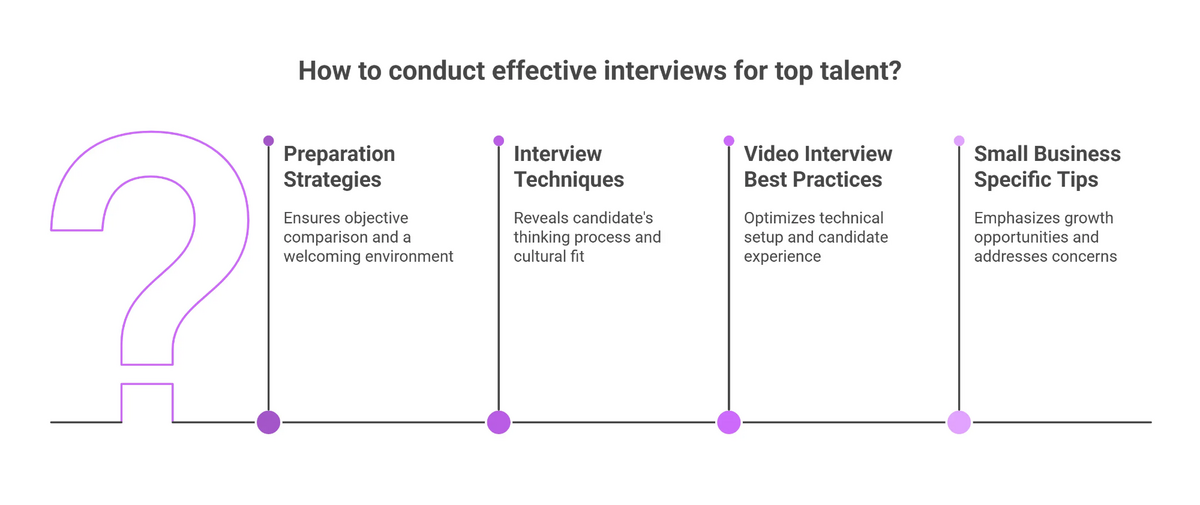
Effective interviewing is your secret weapon for identifying top talent who will thrive in your small business environment. These proven strategies help you compete with larger companies while maintaining your personal touch.
Preparation Strategies
Use the Same Questions for All Applicants
Develop a core set of 8-10 questions that every candidate answers. This standardization allows you to compare responses objectively and ensures legal compliance. Create role-specific questions for technical skills while maintaining consistent behavioral and culture fit questions across all candidates.
Create a Welcoming Environment
Your interview setting reflects your company culture. Choose a comfortable space with good lighting and minimal distractions. Offer water or coffee, and ensure candidates know where to park and enter the building. A positive first impression sets the tone for honest, productive conversations.
Structured Interview Frameworks
Allocate specific time blocks for different interview components: introductions (5 minutes), experience review (20 minutes), behavioral questions (15 minutes), candidate questions (10 minutes), and next steps (5 minutes). This structure keeps interviews on track while ensuring comprehensive evaluation.
Interview Techniques
Ask Open-Ended Questions That Prompt Experience Sharing
Instead of "Are you good at problem-solving?" ask "Tell me about a time you solved a complex problem at work. What was your approach?" Open-ended questions reveal thinking processes, communication skills, and real experience rather than rehearsed yes-no answers.
Behavioral vs. Situational Questions
Behavioral questions ("Tell me about a time when...") assess past performance, which predicts future behavior. Situational questions ("What would you do if...") evaluate problem-solving approach. Use 70% behavioral and 30% situational questions for the most accurate assessment.
Cultural Fit Assessment
Evaluate alignment with your company values through scenario-based questions. Ask about preferred work environments, communication styles, and motivation drivers. Look for enthusiasm about your company's mission and realistic expectations about small business dynamics.
Video Interview Best Practices
Technical Setup Considerations
Test your video platform beforehand and have backup options ready. Ensure strong internet connection, good lighting, and professional background. Position cameras at eye level and eliminate potential distractions like notifications or background noise.
Candidate Experience Optimization
Send clear instructions including platform access, expected duration, and technical requirements. Provide a contact method for technical issues and consider offering a brief tech check before the actual interview. Remember that technical difficulties can unnecessarily stress candidates.
Hirevire Advantages: No-login required eliminates technical barriers for candidates, mobile compatibility allows flexible scheduling, and multiple recording attempts let candidates present their best selves without the pressure of real-time perfection.
Small Business Specific Tips
Emphasize Growth Opportunities
Highlight how the role can evolve as the company grows. Share specific examples of current employees who've advanced or expanded their responsibilities. Explain how small teams mean faster skill development and direct exposure to different business areas.
Showcase Company Culture
Let candidates meet potential teammates during the interview process. Share authentic stories about team collaboration, company traditions, or how decisions are made. Be honest about both the exciting opportunities and realistic challenges of working in a growing business.
Address Concerns About Small Company Stability
Proactively discuss financial health, growth trajectory, and risk mitigation strategies. Share client retention rates, revenue growth, or recent wins that demonstrate stability. Acknowledge that small businesses carry different risks and rewards compared to large corporations.
Leverage Your Personal Touch
Use your founder or leadership story to connect with candidates emotionally. Explain your vision for the company and how this role contributes to that vision. Candidates often choose small businesses for the personal connection and meaningful impact they can't get elsewhere.
Be Transparent About Expectations
Clearly communicate both the exciting opportunities and realistic challenges. Discuss workload expectations, resource constraints, and the need for flexibility. Candidates who choose small businesses despite these realities are more likely to succeed and stay long-term.
Close with Clear Next Steps
End every interview by explaining your timeline and next steps in the process. Let candidates know when they can expect to hear back and provide a contact method for follow-up questions. This professionalism reinforces your company's credibility and respect for candidates' time.
Hiring Your First Employee: A Founder's Guide
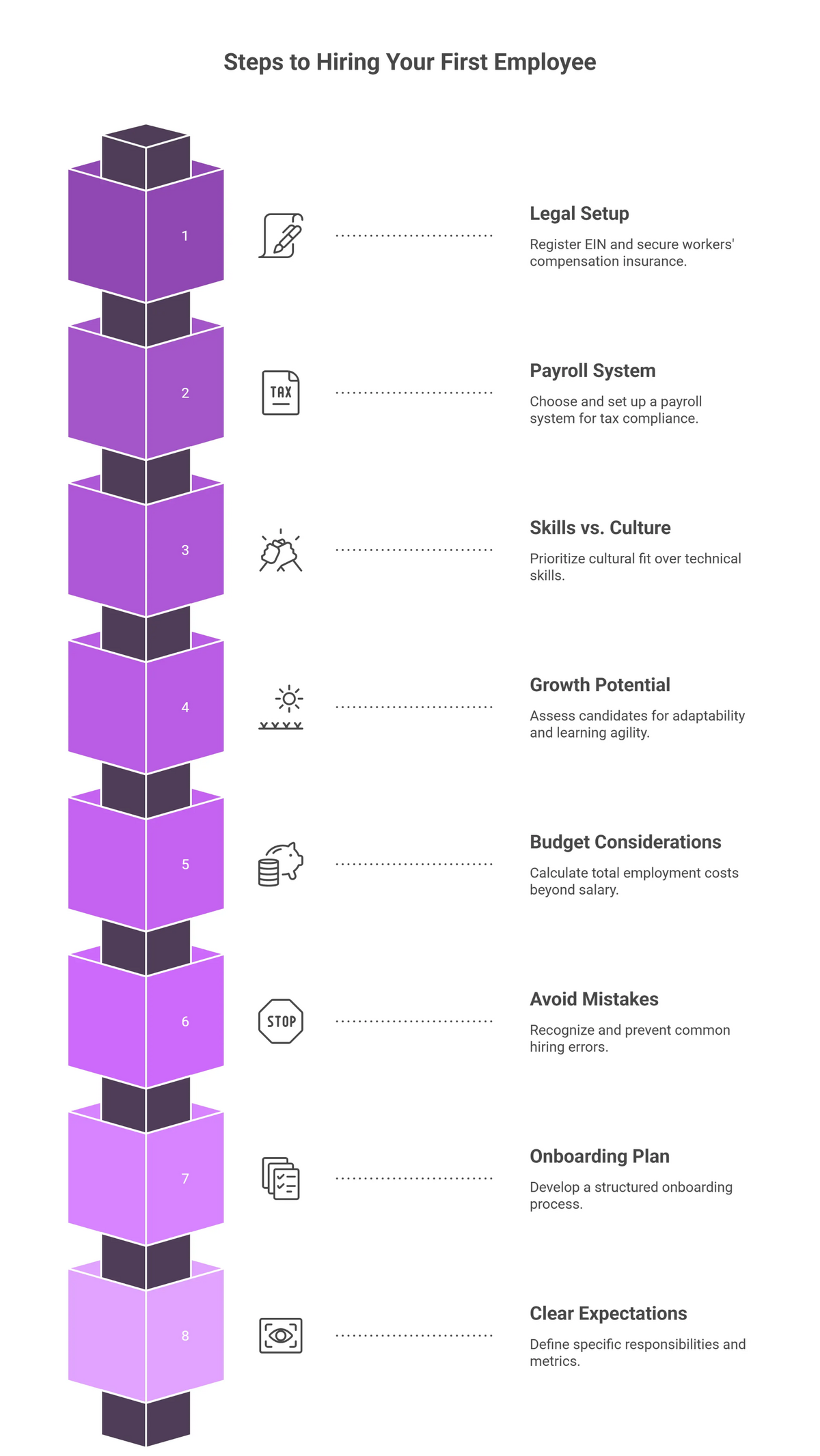
Making your first hire marks a pivotal moment in your business journey. This decision will shape your company culture and growth trajectory. Here's how to navigate this crucial milestone successfully.
Legal and Administrative Setup
EIN Registration
Obtain an Employer Identification Number (EIN) from the IRS before hiring anyone. This free online process takes minutes and is required for payroll taxes, workers' compensation, and unemployment insurance.
Workers' Compensation Insurance
Most states require workers' compensation coverage as soon as you hire your first employee. Contact your business insurance agent to add this coverage before your employee's start date. Costs typically range from $0.75 to $2.74 per $100 of payroll.
Payroll System Setup
Choose between payroll software like QuickBooks or Gusto, or outsourcing to a payroll service. Factor in federal and state tax withholdings, Social Security, Medicare, and unemployment taxes. Professional payroll services often cost less than manual processing risks.
Employment Law Compliance
Familiarize yourself with Fair Labor Standards Act requirements, Equal Employment Opportunity guidelines, and state-specific minimum wage and workplace posting requirements.
Making the Right Choice
Skills vs. Culture Fit Balance
For your first hire, prioritize cultural alignment over perfect technical skills. You can teach competencies, but changing work ethic or communication style is nearly impossible. Look for candidates who embrace your mission and adapt as the business evolves.
Growth Potential Assessment
Evaluate learning agility and adaptability rather than just current expertise. Your first employee will likely wear multiple hats and grow with the company, so flexibility matters more than narrow specialization.
Budget Considerations
Calculate total employment costs beyond salary: payroll taxes (7.65%), workers' compensation (1-3%), benefits, equipment, and training time. Budget for 125-130% of base salary to cover all employment-related expenses.
Common First-Hire Mistakes
The Warm Body Syndrome - Hiring Quickly Without Proper Assessment
Resist the urge to hire the first acceptable candidate just to fill the position quickly. A bad first hire can damage team morale, waste training resources, and hurt your company's reputation before it's established.
Underestimating Onboarding Needs
Create a structured onboarding plan covering company procedures, tool access, role expectations, and cultural integration. Poor onboarding leads to confusion, decreased productivity, and early turnover.
Unclear Role Expectations
Define specific responsibilities, success metrics, and reporting relationships. Document expectations in writing to prevent misunderstandings and provide clear performance benchmarks.
Why Hirevire is Perfect for First-Time Hiring Managers
As a founder making your first hire, you're juggling business operations while learning recruitment best practices. Hirevire eliminates the complexity of coordinating schedules and managing multiple communication channels.
The platform's automated video screening lets candidates respond on their own time while giving you deeper insights than traditional phone screens. You can review responses when convenient, share them with advisors for input, and make informed decisions without real-time interview pressure.
With no technical setup required and intuitive design, Hirevire removes the learning curve that complex hiring software requires. You focus on evaluating candidates rather than managing technology, making your first hiring experience efficient and stress-free.
Plus, with a G2 rating of 4.7/5 stars, Capterra rating of 5/5 stars. AppSumo rating of 4.9/5, Hirevire becomes an even more sought-after tool for small business hiring.
How to Streamline Recruitment and Selection
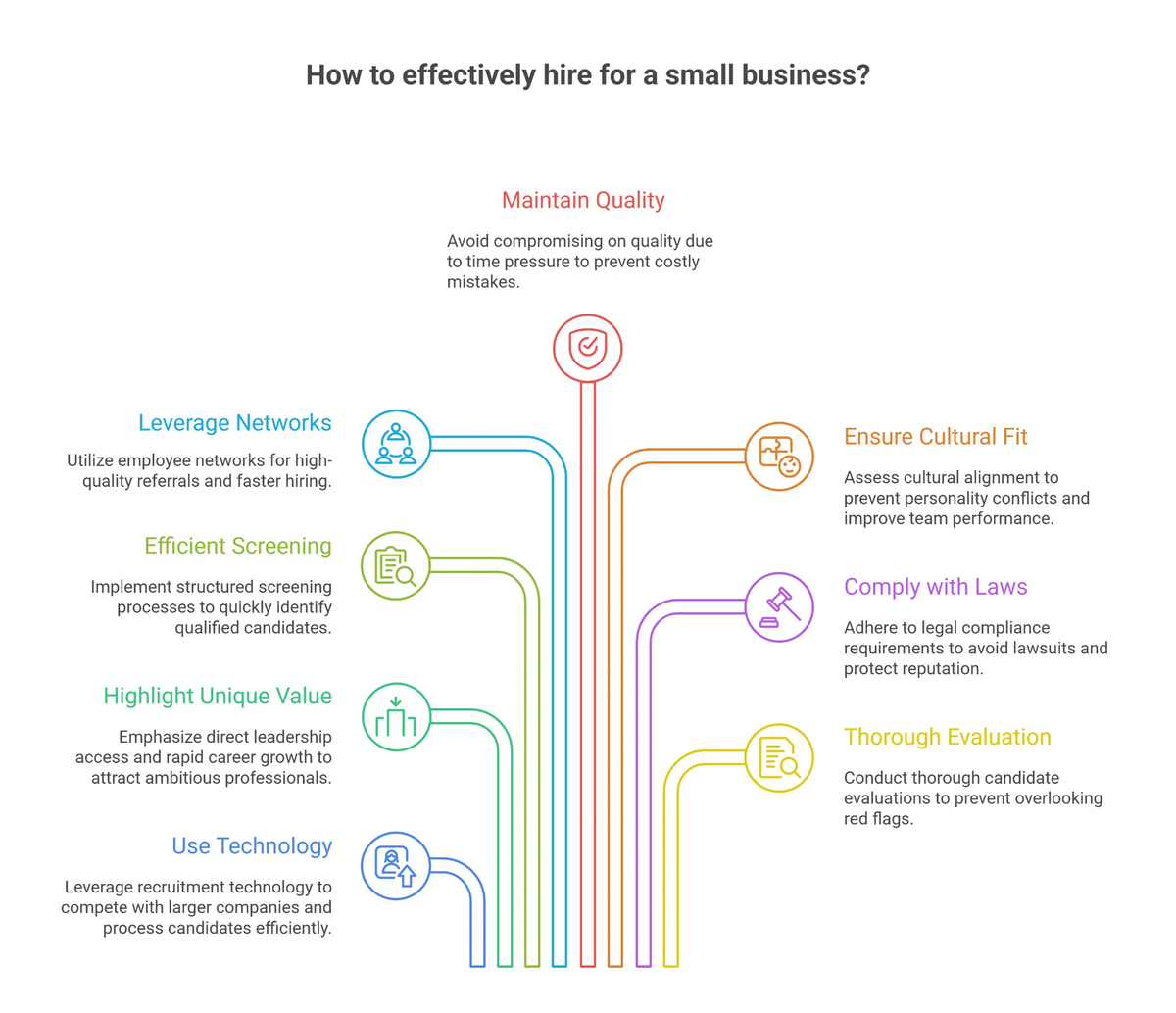
Small businesses often struggle with hiring inefficiencies that drain time and resources. By streamlining your recruitment process, you can reduce hiring costs, improve candidate experience, and make better hiring decisions faster.
Process Automation
Automating Recruitment Process for Startups is One of the Most Effective Ways to Reduce Repetitive Hiring Tasks and Streamline Hiring Costs
Manual recruitment processes consume valuable time that small business owners should spend growing their business. Automation eliminates repetitive tasks like scheduling, sending follow-up emails, and organizing candidate information, reducing administrative overhead by up to 40%.
Technology Integration Benefits
Modern recruitment technology connects seamlessly with your existing business tools. Integration eliminates data silos, reduces manual data entry, and ensures consistent communication across platforms. When your recruitment system syncs with your calendar, email, and project management tools, the entire hiring process becomes more efficient.
Time-Saving Strategies
Focus automation on high-volume, low-value tasks first. Automate application acknowledgments, interview scheduling, and status updates to candidates. Use templates for common communications while maintaining personalization through merge fields. Set up automated workflows that trigger based on candidate actions or time intervals.
Efficiency Improvements
Bulk Candidate Processing
Process multiple candidates simultaneously rather than individually. Create standardized evaluation criteria that allow quick comparison across large candidate pools. Use batch operations for sending communications, updating statuses, and scheduling interviews. This approach reduces the per-candidate time investment while maintaining consistency.
Automated Communication
Set up triggered email sequences for different stages of your hiring process. Send automatic acknowledgments when applications are received, status updates when candidates advance or are declined, and reminder emails for upcoming interviews. Automated communication keeps candidates informed while reducing your administrative workload.
Streamlined Evaluation
Implement structured scoring systems that allow quick candidate comparison. Create evaluation templates with standardized criteria and rating scales. Use collaborative tools that allow team members to provide feedback efficiently. Standardization reduces decision time while improving hiring quality.
Hirevire's Role in Streamlining
All-in-One Platform Benefits
Hirevire eliminates the need for multiple tools by combining application collection, screening, and evaluation in a single platform. Instead of managing spreadsheets, email chains, and separate scheduling tools, everything happens in one organized system. This consolidation reduces complexity and training time for your team.
Integration Capabilities (5000+ Apps via Zapier)
Connect Hirevire with your existing business tools through 5000+ Zapier integrations. Automatically create calendar events when candidates complete screening, add qualified candidates to your CRM, or trigger Slack notifications when new applications arrive. These integrations eliminate manual data transfer and keep your entire team informed.
Automated Email Workflows
Set up sophisticated email sequences that respond to candidate actions automatically. Send personalized acknowledgments immediately after application submission, follow-up reminders for incomplete screenings, and status updates based on evaluation results. These workflows maintain professional communication without constant manual oversight.
Multi-Format Response Collection
Collect video responses, audio recordings, file uploads, and written answers through a single candidate link. This flexibility accommodates different candidate preferences while providing comprehensive evaluation data. Candidates can complete their entire application process in one session, reducing drop-off rates and improving completion times.
Measurable Efficiency Gains
Organizations using Hirevire typically reduce their screening time by 75% while improving candidate assessment quality. The platform's automated features eliminate scheduling conflicts, reduce email back-and-forth, and provide better candidate insights than traditional phone screens.
Cost-Effective Scaling
As your hiring volume increases, Hirevire's automation capabilities scale without proportional increases in administrative time. Whether you're hiring one person or twenty, the per-candidate effort remains consistent, allowing you to grow your team efficiently without expanding your recruitment workload.
Streamlined recruitment isn't about cutting corners – it's about eliminating inefficiencies so you can focus on what matters most: identifying and attracting the right talent for your growing business.
Small Business Hiring Dos and Don'ts
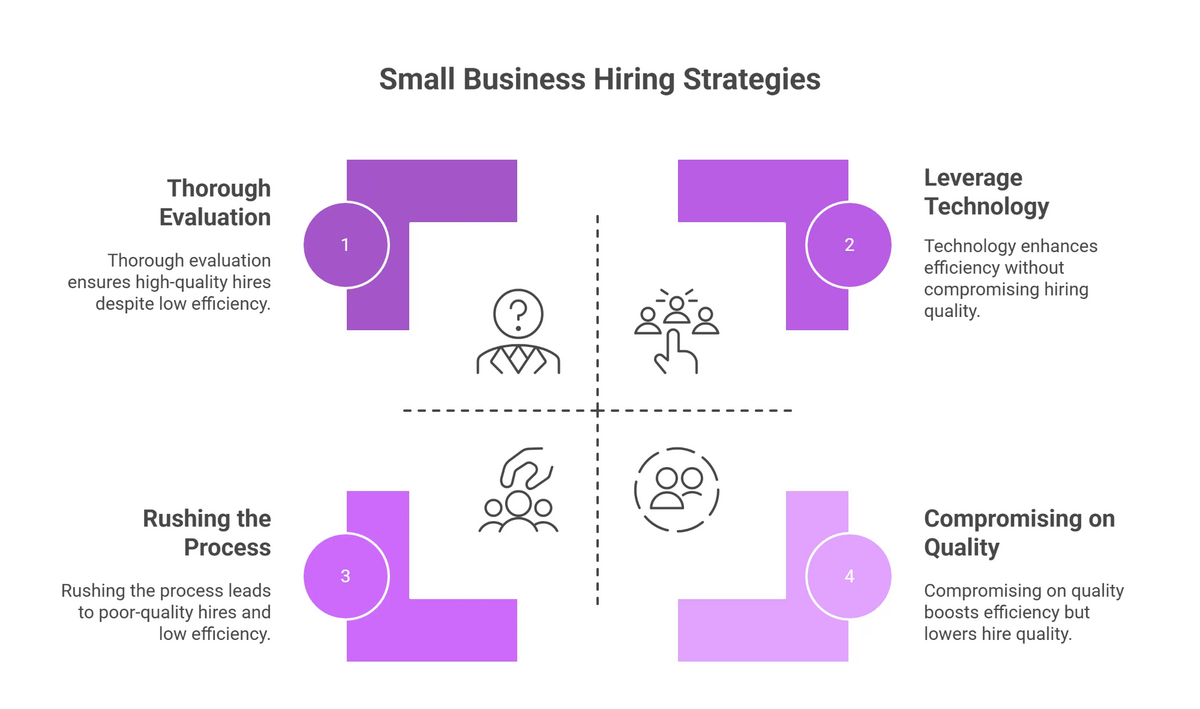
Successful small business hiring requires knowing what to prioritize and what mistakes to avoid. These essential guidelines help you make smart decisions that support long-term growth.
DO:
✅ Use Technology to Level the Playing Field
Leverage recruitment technology to compete with larger companies' resources. Automated screening tools, video interviews, and integrated platforms give you enterprise-level capabilities at small business prices. Technology helps you process more candidates efficiently while maintaining professional presentation standards.
✅ Highlight Your Unique Value Proposition
Emphasize what large corporations can't offer: direct access to leadership, rapid career growth, meaningful impact on company direction, and the opportunity to wear multiple hats. Position these advantages as accelerators for ambitious professionals who want to make a real difference.
✅ Create Efficient Screening Processes
Implement structured screening that quickly identifies qualified candidates while providing insights beyond resumes. Use standardized questions, scoring systems, and automated workflows to maintain consistency. Efficient screening saves time for both you and candidates while improving hiring quality.
✅ Leverage Employee Networks
Your team's professional networks often yield the highest-quality candidates. Implement referral programs with meaningful incentives, ask employees to share job postings on social media, and encourage networking within industry groups. Referred candidates are typically hired faster and stay longer.
DON'T:
❌ Compromise on Quality Due to Time Pressure
Desperation leads to poor hiring decisions that cost more than leaving positions temporarily unfilled. A bad hire can damage team morale, waste training resources, and hurt productivity. Maintain your standards even when facing urgent staffing needs or pressure to fill roles quickly.
❌ Overlook Cultural Fit
Skills can be taught, but cultural alignment cannot be easily changed. Assess candidates' work style, communication preferences, and values alignment alongside technical qualifications. In small teams, personality conflicts or misaligned expectations have outsized negative impacts on overall performance.
❌ Ignore Legal Compliance Requirements
Employment law violations can result in costly lawsuits and damage your reputation. Ensure job descriptions use inclusive language, interview questions avoid protected characteristics, and hiring decisions are documented with objective criteria. Stay current on federal and state employment regulations.
❌ Rush the Process Without Proper Evaluation
Thorough candidate evaluation prevents costly mistakes. Always check references, verify qualifications, and involve key team members in the decision process. Rushing leads to overlooking red flags, missing better candidates, and making decisions based on incomplete information.
Key Takeaways
Smart small business hiring balances efficiency with thoroughness. Use technology and structured processes to move quickly while maintaining high standards for candidate quality and cultural fit. Remember that your hiring decisions have greater impact in smaller organizations, making careful evaluation essential for long-term success.
Focus on what makes your business attractive to top talent while avoiding shortcuts that compromise quality. The right approach turns your size into a competitive advantage rather than a limitation.
Recruitment Plans for Small Businesses
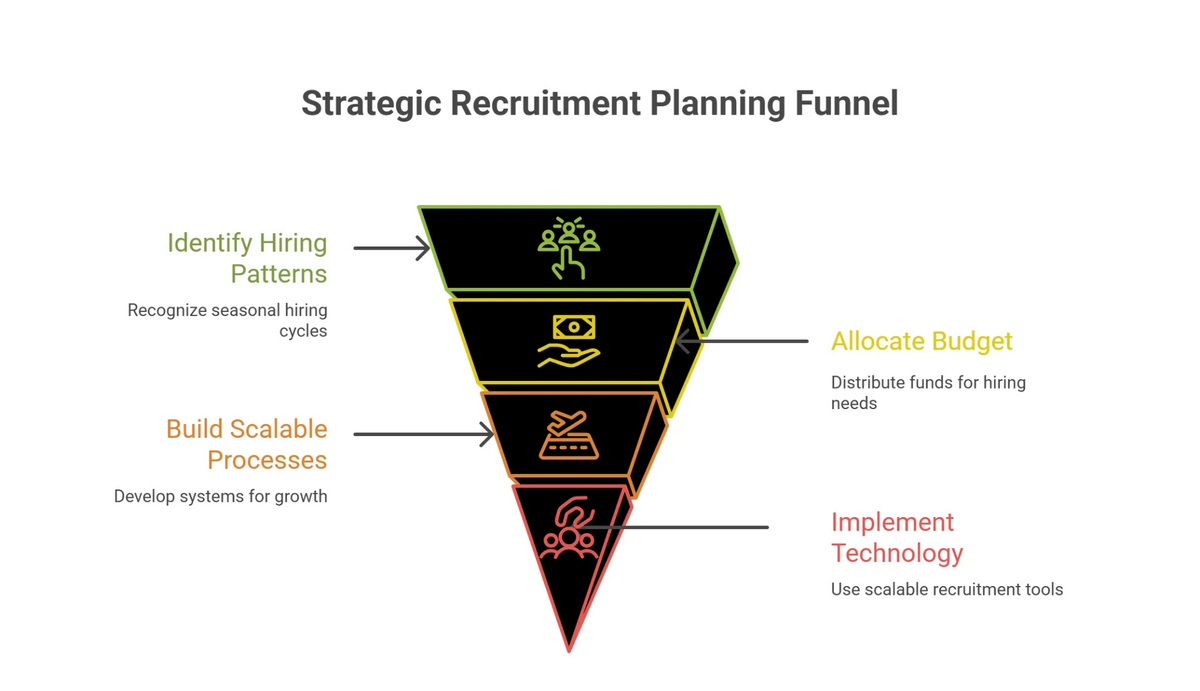
Strategic recruitment planning helps small businesses anticipate hiring needs, allocate resources effectively, and build scalable processes that support sustainable growth.
Annual Planning
Seasonal Hiring Patterns
Identify your business's natural hiring cycles based on revenue patterns, project timelines, and industry trends. Many businesses see increased hiring in Q1 as budgets reset, while others hire heavily before busy seasons. Document these patterns to plan recruitment activities and budget allocation in advance.
Budget Allocation Strategies
Allocate 15-20% of annual revenue for total employee costs, including salaries, benefits, and hiring expenses. Break this down quarterly, accounting for seasonal variations and growth goals. Reserve 10-15% of your hiring budget for unexpected opportunities or urgent replacements.
Growth Projections
Align hiring plans with realistic business growth projections. Plan for different scenarios: conservative (20% growth), expected (40% growth), and aggressive (60% growth). Each scenario requires different staffing levels and hiring timelines. Update projections quarterly based on actual performance and market conditions.
Scalable Processes
Systems That Grow With Your Business
Build recruitment processes that handle increased volume without proportional increases in time investment. Start with simple, repeatable workflows that can be automated or delegated as you grow. Document procedures, create templates, and establish quality standards that remain consistent regardless of hiring volume.
Use technology that scales from individual hires to high-volume recruitment without requiring system changes. Choose platforms with flexible pricing that grow with your needs rather than forcing upgrades as you expand.
Create role-specific hiring templates that can be quickly customized for new positions. Develop standard job descriptions, interview questions, and evaluation criteria that maintain consistency while allowing role-specific customization.
Hirevire Scalability: From 1-2 Hires to High-Volume Recruitment
Hirevire adapts seamlessly as your hiring needs evolve. Whether you're making your first hire or recruiting twenty people, the platform maintains the same efficiency levels. The automated screening capabilities handle increased candidate volume without requiring additional time investment from your team.
As you scale, Hirevire's team collaboration features allow multiple stakeholders to review candidates simultaneously, while integration capabilities connect with business tools you adopt during growth. The platform's flexible pricing structure means you only pay for what you use, making it cost-effective at any hiring volume.
Technology Solutions That Level the Playing Field
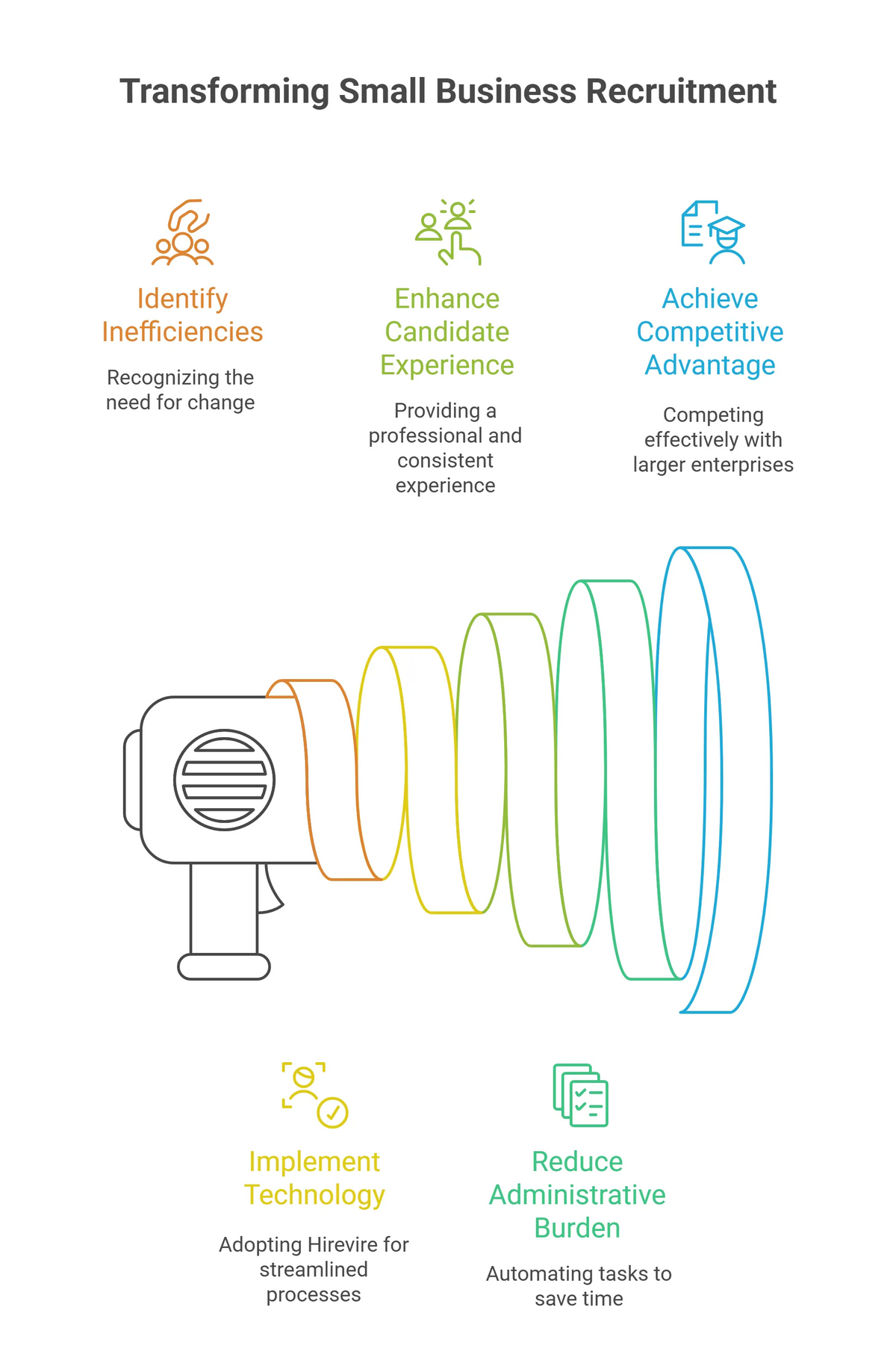
Small businesses can now compete with enterprise-level recruitment capabilities through the right technology choices. The key is selecting tools that deliver maximum impact without overwhelming complexity or costs.
Why Technology Matters
The Most Common Hiring Technology Stack for Small Businesses Today is Built Around Their Spreadsheets and Email
This disjointed setup leads to inefficient recruiting and slow hiring processes. Candidate information gets scattered across multiple emails, spreadsheets become outdated quickly, and team members struggle to access current application status. Important details fall through the cracks, scheduling becomes a coordination nightmare, and the candidate experience suffers.
Breaking Free from Manual Processes
Manual hiring processes consume disproportionate time that small business owners should spend growing their business. Administrative tasks like scheduling interviews, sending status updates, and organizing candidate information can consume 15-20 hours per hire. This time investment becomes unsustainable as hiring volume increases.
Professional Presentation Challenges
Enterprise companies present polished, consistent candidate experiences through sophisticated HR platforms. Small businesses using email and spreadsheets often appear disorganized, potentially losing quality candidates who judge company competence based on hiring process efficiency.
Hirevire as the Solution
Cost-Effective Pricing ($39/month vs. Spark Hire's $149)
Hirevire delivers enterprise-level capabilities at small business prices. Starting at just $39 per month for the One Job plan, it costs significantly less than competitors like Spark Hire at $149 monthly. This pricing makes professional recruitment technology accessible without straining budgets.
Comprehensive Feature Set
Unlike piecemeal solutions requiring multiple tools, Hirevire provides everything needed for modern recruitment: video screening, audio responses, file collection, team collaboration, automated workflows, and integration capabilities. This comprehensive approach eliminates coordination between different platforms while ensuring nothing falls through the cracks.
Easy Implementation
Setup takes minutes, not weeks. No complex configurations, lengthy training sessions, or technical expertise required. You can launch your first screening campaign within an hour of signing up, immediately improving your hiring process without implementation delays.
No Technical Expertise Required
The platform's intuitive design means anyone can use it effectively regardless of technical background. Candidates require no login or special software, reducing friction and increasing completion rates. Team members can access and review candidates without training, making adoption seamless.
With Hirevire, small businesses can offer candidate experiences that rival Fortune 500 companies, transforming hiring from an administrative burden into a strategic competitive advantage.
Conclusion & Next Steps
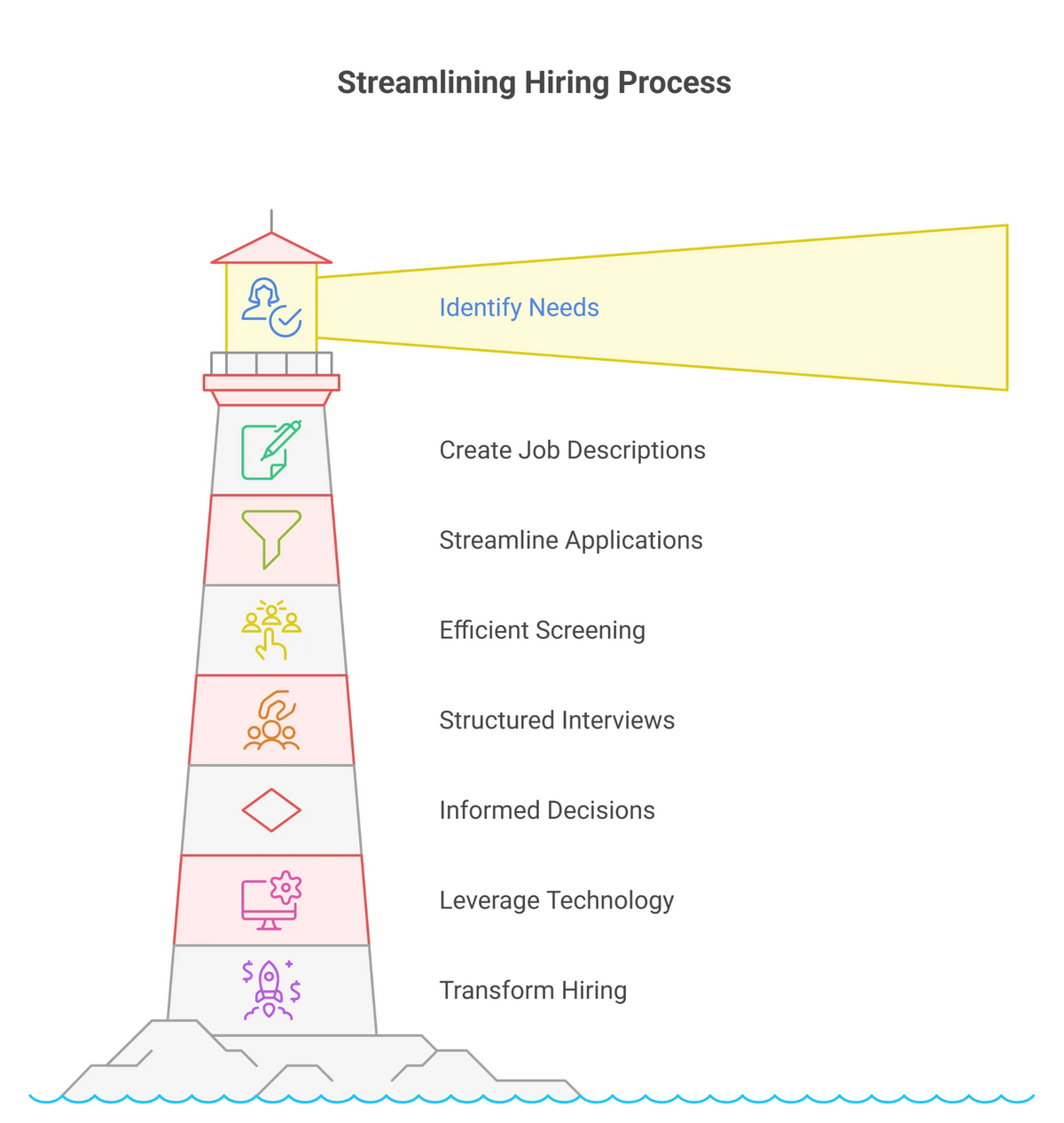
Small business hiring doesn't have to be overwhelming or inefficient. By following this complete guide, you now have the roadmap to build a hiring process that attracts top talent while saving time and money.
Recap Key Strategies
Remember the fundamentals: identify your hiring needs clearly, create compelling job descriptions that highlight your unique advantages, streamline your application collection, and implement efficient screening processes. Use structured interviews, make informed decisions quickly, and leverage technology to compete with larger companies.
Emphasize Competitive Advantages
Your size is your strength. You offer faster decision-making, personal candidate experiences, genuine growth opportunities, and authentic company culture that enterprise companies simply cannot match. The key is positioning these advantages strategically while using the right tools to present professionally.
Transform Your Hiring Process Today
Stop struggling with spreadsheets and endless email chains. Hirevire's automated video screening platform eliminates scheduling conflicts, provides deeper candidate insights, and scales with your business growth. Starting at just $39 per month, it delivers enterprise-level capabilities at small business prices.
Ready to streamline your hiring process? Try Hirevire free for 14 days and experience how automated screening can transform your recruitment efficiency. Join hundreds of small businesses that have already enhanced their hiring process and are competing successfully for top talent.
Visit the small business landing page to get started and take your hiring process from good to exceptional.
Frequently Asked Questions
1. How much should small businesses budget for hiring?
Small businesses should budget around 125-130% of an employee’s base salary to cover total employment costs including payroll taxes, benefits, and equipment. When considering recruitment technology, platforms like Hirevire, which starts at $39 per month, often pay for themselves with the time saved and improved candidate quality achieved through video screening and AI-powered evaluation.
2. How much time does proper hiring actually take?
Traditional hiring processes typically take about 23.8 days and involve 15-20 hours of administrative work per hire. With automated screening tools like Hirevire, administrative time can be cut by up to 75%, allowing HR teams to focus their evaluation efforts on the most qualified candidates rather than coordinating interviews or sorting through unqualified applications.
3. What legal requirements must small businesses follow when hiring?
Small businesses must comply with Equal Employment Opportunity laws, provide reasonable accommodations under the Americans with Disabilities Act (ADA), adhere to the Fair Labor Standards Act, and meet any state-specific wage and workplace posting requirements. Using inclusive job descriptions and avoiding questions about protected characteristics are best practices. Hirevire supports this by enabling structured, standardized interviews that help ensure fairness and consistent compliance.
4. Is hiring technology too complex for small businesses?
Thanks to modern platforms like Hirevire, hiring technology is no longer complex. Setup can be completed within minutes, candidates do not need any special software or accounts, and team members can quickly start using the platform without extensive training. Hirevire simplifies the hiring process by providing intuitive video interviews, AI-driven scoring, and seamless collaboration tools.
5. What’s the ROI of investing in hiring technology?
For most small businesses, the ROI of investing in hiring technology like Hirevire is realized with the very first hire. Time saved on administrative tasks, higher candidate quality, and faster hiring decisions reduce the risk and cost of a bad hire, which often exceeds the price of technology investment annually.

